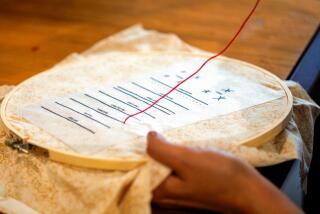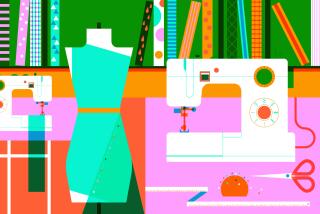TRENDS : New technology on machines and sergers makes sewing faster and easier. So go back to spool.
- Share via
Home sewing has gone high-tech. A new generation of machines has tiny computer screens, track balls and interchangeable pro grams. They can switch from straight stitch to buttonholes to fancy embroidery without complicated attachments. Then there’s the serger, a smaller machine that uses up to five cone-shaped spools of thread at once.
Sound intimidating? Perhaps. But those who have made the leap to computerized machines and sergers say sewing has never been easier or more exciting.
Such enthusiasm for the new machines is a godsend for the home-sewing industry, which has suffered from lax sales and declining consumer interest since the 1970s. But now the American Home Sewing & Craft Assn. is preparing to revamp sewing’s homespun image--actress/model Lauren Hutton has been hired as national spokeswoman--and attract new recruits. A particular emphasis will be placed on home decor, because pillows, drapes and bed fashions are easy projects for beginners and make the coveted “designer look” affordable.
So what are these new machines, and why should those with little time to sew be excited about them?
First, there’s the serger, which sews seams at 1,500 stitches per minute, trims off excess fabric and finishes raw edges all in one pass.
Sergers have been around for more than 40 years in commercial sewing operations, but scaled-down versions for the home were developed within the past 10 years.
In addition to sewing faster, the serger makes a stronger seam than conventional sewing machines. Its system of needles and loopers forms a network of interlocking stitches that extend over the edge of the seam, which is why the serger is sometimes called an overlock machine.
A similar seam sewn on top of the fabric is called a flatlock, commonly seen on T-shirts, sweat shirts and exercise wear. Slow to catch on, the serger is now considered indispensable by many home-sewing enthusiasts.
“I use mine constantly,” said Sherri Wolf, who teaches home-decorating sewing at Saddleback College in Mission Viejo. “It’s 10 times faster and makes things so much easier. Once you own one, you’ll sew more,” said Wolf, who is making drapes for her home almost exclusively on a serger. “I would have never attempted this without it.”
For everyone who has wrestled with keeping even one spool of thread and one bobbin operating in concert, the serger with its four to five spools of thread can seem daunting.
Although an experienced seamstress, Wolf admits to being intimidated at first by the serger’s multiple threads and complicated appearance.
“But once I got started on it, I couldn’t live without it. The serger makes sewing so much easier that I can take on twice as many projects,” said Wolf, who also teaches a course in overcoming serger phobia at Piecemakers Country Store in Costa Mesa.
Her simple approach has helped numerous serger owners understand the machine’s threading and tension process. “It’s a matter of knowing where each thread goes and what its purpose is in creating the seam,” Wolf said. “A simple rule of thumb when adjusting tension is to tighten what appears too loose and loosen what appears too tight. Everyone catches on with a little practice and understanding.”
Using a serger, you can sew a ruffled pillow sham in minutes because the serger’s ruffling attachment will gather the fabric evenly as you sew, attach the ruffle and finish the seam all at once. The same process is used for sewing bed ruffles and valances.
Another home-decorating advantage is the serger’s ability to sew a wider range of fabrics, including drapery sheers and medium-weight upholstery materials. In fact, the machine’s narrow, rolled-edge stitch is often used to give ruffled curtain sheers the delicate, billowy appearance of custom-sewn draperies. Use of the serger’s differential feed option allows the user to sew straight and even stitches on lightweight fabrics with no puckering.
However amazing the serger may seem, it can’t do it all. For example, it doesn’t do buttonholes or zippers. Sergers were designed to be used in tandem with conventional sewing machines, in which there are also many new developments.
Traditional sewing machine stitches are made by a mechanical cam linked to the sewing machine needle. Most are capable of only 40 kinds of stitches.
In computerized machines, the cam is replaced by a tiny computer chip, allowing a wider variety of stitch options and, in some machines, memory storage for custom-designed stitches.
The state-of-the-art Bernina 1630 computerized machine, for example, contains five pre-programmed alphabets, motifs and decorative borders that can be embroidered onto clothing and table and bed linens at the touch of a few buttons.
For those who want to design their own embellishments, the machine will allow you to “sketch” the stitch on its display screen using the machine’s track ball, a process similar to drawing on a computer screen using a mouse.
In fact, many computerized machines will eventually allow users to do just that. Manufacturers are devising ways to link sewing machines to the home PC, allowing users to scan in or draw a design to be stitched on the machine. Custom-designed stitches can be stored in the machine’s memory.
“The computerized machines are more expensive, but they are easy to use and provide many options,” said Steve Ferris, a mechanical engineer and owner of Capistrano Sewing Machine and Vacuum Co. in San Juan Capistrano. “They also have a direct current motor, which allows you to work on thicker fabrics, even at low speeds.”
Most computerized machines come with an electronic sensor device that tells the user when the bobbin is running low. Another sensor automatically adjusts tension according to fabric and stitch selection. A user-friendly tutorial appears on the machine’s display screen to inform the user how to use the machine’s features. It also indicates which presser foot to use according to the stitch selected.
“The computerized machines give the user a chance to be creative in a way that’s not possible on a regular machine,” Ferris said. “People tend to rediscover sewing when they learn what their new machine is capable of.”
That attitude is precisely what the Home Sewing & Craft Assn. is hoping will bring new energy to the industry.
Whether you sew occasionally or often, you will probably enjoy checking out the new machines. It’s likely you’ll see machines with features you never dreamed of, especially if you purchased your current machine 10 or more years ago.
While sewing ultimately is still the process of attaching pieces of fabric one to another, the machines to do it have changed dramatically.
Basic Machine Stitch
Seam sewn by conventional sewing machine using two threads, one top and one bottom, that interlock at even intervals. Edge is left unfinished. All-purpose stitch used on cottons and other fabrics that dont unravel easily.
Serger Safety Stitch
Four-thread seam sewn by a serger. The top row of stitching overlocks the unfinished edge on both sides of the fabric. A separate row of stitching runs underneath, forming a stable, lightweight seam. Often used on woven fabrics, such as woolens.
Serger Mock Safety Stitch
Variation of a four-thread safety stitch. The fabric edge is overlocked on both sides, and a safety stitch runs down the middle of the seam, instead of below it. Allows the fabric to stretch while providing additional stability. Used primarily on knits.
Sewing Machines
The person who sews in the ‘90s has a range of machines available. Three basic types and what each does:
SERGER
Sews seam, trims fabric and finishes seam edge in one pass
Up to 1,500 stitches per minute
Stronger, commercial quality seam with three or more threads instead of two
Wide range of fabrics including lightweight sheers and medium-weight upholstery
More suitable for knit fabrics, due to strength and flexibility of seam
Cost: $500-$1,500
COMPUTERIZED MACHINE
Wide range of stitches, including multiple alphabets, motifs and numerals
Up to 1,000 stitches per minute
Uses two threads
Sews heavy fabrics, even at slow speeds
Some allow users to design own stitches and embroidery motifs
Attachments becoming available for some models that allow link to personal computer
Cost: $1,000-$3,500
REGULAR MACHINE
* Sews straight stitch, zig-zag and approximately 20 decorative stitches
* Sews 200-1,000 stitches per minute
* Uses two threads
* Cannot handle extra-thick fabrics
* Lower price ($200-$800) makes this good machine for occasional sewers
Source: Individual manufacturers; Researched by JANICE L. JONES / Los Angeles Times
Buying Tips
Here are some things to consider when shopping for a serger or computerized sewing machine:
* Shop around: Don’t assume that the manufacturer of your old-reliable sewing machine also makes a quality serger or computerized machine. Try out several brands and ask knowledgeable friends which they prefer.
* Price: Expect to pay $500 to $1,500 for a quality serger. Computerized sewing machines run $1,000 to $3,500.
* Trade-ins: Many people buy less-expensive machines and then trade up to high-end models when their needs and skills advance. Many dealers accept trade-ins as credit toward a new machine. Used models are often available at one-third to one-half off.
* Try it yourself: Bring samples of fabrics you like to work with and ask to sew them yourself on the machine you are considering. Be sure to get a thorough demonstration of the machine.
* What to look for: Machines vary according to quality of stitch and ease of use. Sample all of the machine’s features and make notes for comparison among models. Pick one that makes an even, attractive stitch and is relatively simple to use.
* Number of threads: Sergers utilizing up to four threads are fine for beginning to advanced users. Five-thread machines may be overkill, except for specific purposes.
* Lessons: Many dealers include lessons on your new machine in the purchase price. Classes can save hours of frustration and help you get the most out of your investment.
* In-house repairs: Dealers who service machines in-house instead of shipping them out for repairs are usually the most knowledgeable, and, should you have a problem, repairs can often be done quickly.
PUBLICATIONS
* Sew News: Reviews various machines and provides up-to-date information on the latest developments. Available at fabric shops and sewing machine stores. Published by Peoria, Ill.-based PJS Publications. Information: (309) 682-6626.
* Sewing Decor: Bimonthy magazine devoted to home decor sewing. Sister publication to Sew News. $17.98 for one-year subscription. Information: (800) 926-9868.
* Serger Update: Monthly newsletter on how to use your serger to its fullest capacity. $48 for one-year subscription. Information: (309) 692-6183.
* What to Buy & Why: $3 brochure on purchasing a serger available from PJS Publications-Update Newsletters, News Plaza, Box 1790, Peoria, Ill. 61656. (309) 692-6183.
Researched by JANICE L. JONES / Los Angeles Times

